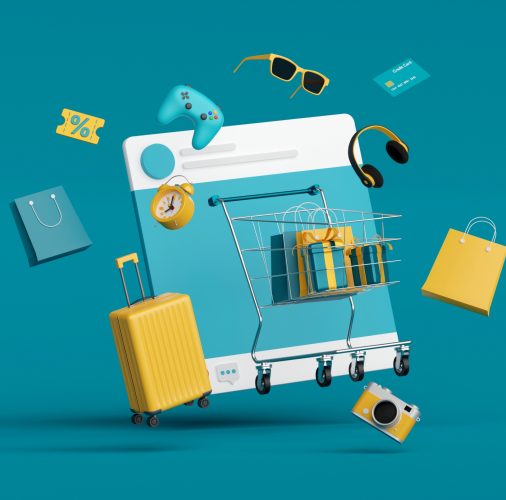User Experience Meets Conversion
The Secrets of Effective E-commerce Website Design
In the rapidly evolving world of online shopping, e-commerce websites face the dual challenge of providing a stellar user experience while driving conversions. A seamless user experience (UX) can significantly influence the decision-making process of potential customers, often making the difference between a casual visitor and a committed buyer. As businesses strive to enhance their digital footprint, understanding the interplay between UX and conversion rates has become paramount. This blog will delve into the key elements of effective e-commerce website design that harmoniously blend user experience with conversion strategies.
Understanding the Importance of User Experience in E-commerce
B. The Connection Between UX and Conversion Conversion rates measure the percentage of visitors who complete a desired action, such as making a purchase or signing up for a newsletter. A well-designed user experience is crucial for increasing these rates. According to a study by the Nielsen Norman Group, websites with a strong UX can lead to conversion rates as high as 400% . This highlights the significant financial impact of prioritizing user-centric design.

Key Elements of Effective E-commerce Website Design
B. Responsive Design With mobile commerce (m-commerce) rapidly gaining traction, a responsive design that adapts seamlessly to various screen sizes is essential. Google reports that over 50% of global website traffic comes from mobile devices . A responsive e-commerce site ensures that all users, regardless of their device, have a consistent experience.
C. Mobile Optimization Mobile optimization goes beyond responsiveness. It involves designing for touch interactions, optimizing loading times, and ensuring that mobile users can easily navigate and complete purchases. Simplifying forms and minimizing pop-ups on mobile devices enhances the shopping experience for users on the go.
Visual Hierarchy and Aesthetics
B. Aesthetic Appeal A visually appealing design can create a sense of trust and professionalism. High-quality images, clean lines, and a cohesive color palette contribute to an inviting atmosphere. Brands like Apple excel at aesthetic design, creating an emotional connection with their customers.

Product Presentation
A. High-Quality Images Research shows that users are significantly more likely to purchase products that are presented with high-resolution images . Multiple angles, zoom features, and lifestyle images can help customers visualize the product in their lives.
B. Compelling Product Descriptions Clear, informative, and persuasive product descriptions are essential. They should address customer pain points and highlight benefits rather than just features. For instance, instead of merely stating the material of a jacket, emphasize its warmth, durability, and style.
Streamlined Checkout Process
A complicated checkout process is one of the leading causes of cart abandonment. According to Baymard Institute, the average cart abandonment rate is around 69.57% . To reduce this, consider the following:
A.Guest Checkout Options
Allowing users to complete purchases without creating an account can significantly increase conversion rates. While accounts offer long-term benefits for user engagement, many customers prefer a quick checkout.
B. Simplified Forms
Minimize the number of fields users must fill out. Use autofill features where possible and clearly indicate required fields to streamline the process.
C. Multiple Payment Options
Offering various payment methods—credit cards, PayPal, digital wallets, etc.—can accommodate different user preferences, making it easier for them to complete purchases.
Trust Signals
B. Customer Reviews and Testimonials Incorporating customer reviews and testimonials can influence potential buyers’ decisions. Authentic user feedback fosters trust and can address common concerns about product quality or service.
Enhancing User Experience Through Personalization
Personalization in e-commerce refers to tailoring the shopping experience to individual users based on their behavior, preferences, and interactions with the brand. A study by Epsilon indicates that 80% of consumers are more likely to make a purchase when brands offer personalized experiences .
Implementing Personalization Strategies
A. Product Recommendations
Utilizing algorithms to suggest products based on users’ browsing and purchasing history can drive additional sales. For example, “Customers who bought this item also bought” sections can lead users to complementary products.
B. Customized Email Marketing
Sending personalized emails based on user behavior, such as abandoned carts or previous purchases, can significantly enhance engagement and drive conversions.
C. User Segmentation
Segmenting users based on demographics, purchase history, and behavior allows for more targeted marketing strategies. Tailored messages and offers can resonate better with specific segments, leading to increased sales.

Testing and Optimization: The Path to Continuous Improvement
A. The Role of A/B Testing
A/B testing, or split testing, is a method where two versions of a webpage are compared to determine which one performs better. This is crucial for optimizing various elements of an e-commerce site, including headlines, CTA buttons, and product layouts.
B. Gathering User Feedback
Regularly soliciting feedback from users can provide insights into pain points and areas for improvement. Tools like surveys, feedback forms, and user testing sessions can help identify issues that may not be immediately apparent.
C. Analytics and Performance Tracking
Using analytics tools to monitor user behaviour on the website is essential for understanding how visitors interact with different elements. Metrics like bounce rates, time on page, and conversion rates can provide valuable insights for optimizing user experience and driving conversions.
The Future of E-commerce Website Design
- Artificial Intelligence and Machine Learning AI and machine learning are increasingly being used to enhance user experience in e-commerce. Chatbots can provide instant customer support, while predictive analytics can offer personalized product recommendations.
- Augmented Reality (AR)AR technology allows users to visualize products in their environment before purchasing. This can significantly enhance the shopping experience, particularly in categories like furniture and fashion
- The Shift Towards Sustainability As consumers become more environmentally conscious, e-commerce brands must consider sustainability in their website design. This includes showcasing eco-friendly practices and offering sustainable products prominently.

